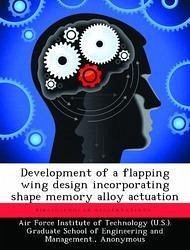This research sought to validate a proof of concept regarding shape memory alloy actuation of a flapping-wing blimp. Specimen wires were subjected to cyclic voltage at increasing frequencies to quantify expected strains. A laser vibrometer captured 2048 sample velocities during single contraction and elongation cycles, and the resulting samples were used to calculate displacements. Displacements were determined ten times for each specimen and frequency to compute averages. Subsequently, a circumventing frame was designed to encase a blimp envelope and provide support for a flapping motion actuation system. Contraction of shape memory wire translated force to the flapping mechanism via bellcranks, pushrods, and clevises, while bias springs promoted elongation of the wire during power-off phases. Performance characteristics of the flapping system, augmented with each specimen wire individually, were determined during bench-top testing. A modified frame was constructed to reduce weight and fitted to a larger envelope due to buoyancy limitations of the original envelope. A circuit was constructed, cycling voltage at 0.2 hertz, to actuate the specimen wires. Performance of the system was observed with the incorporation of each specimen. Optimum performance was realized with the 0.005 inch diameter specimen wire, producing 25 to 35 degrees wing deflection.








